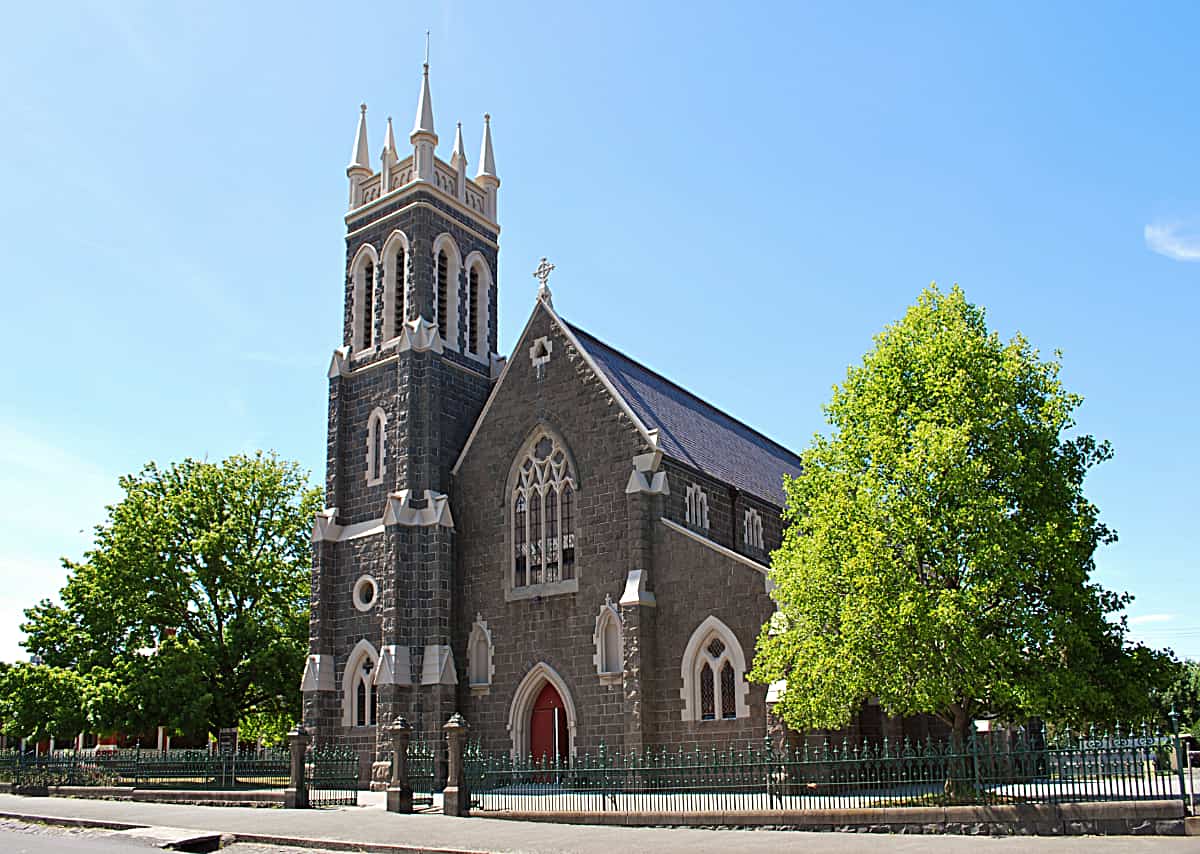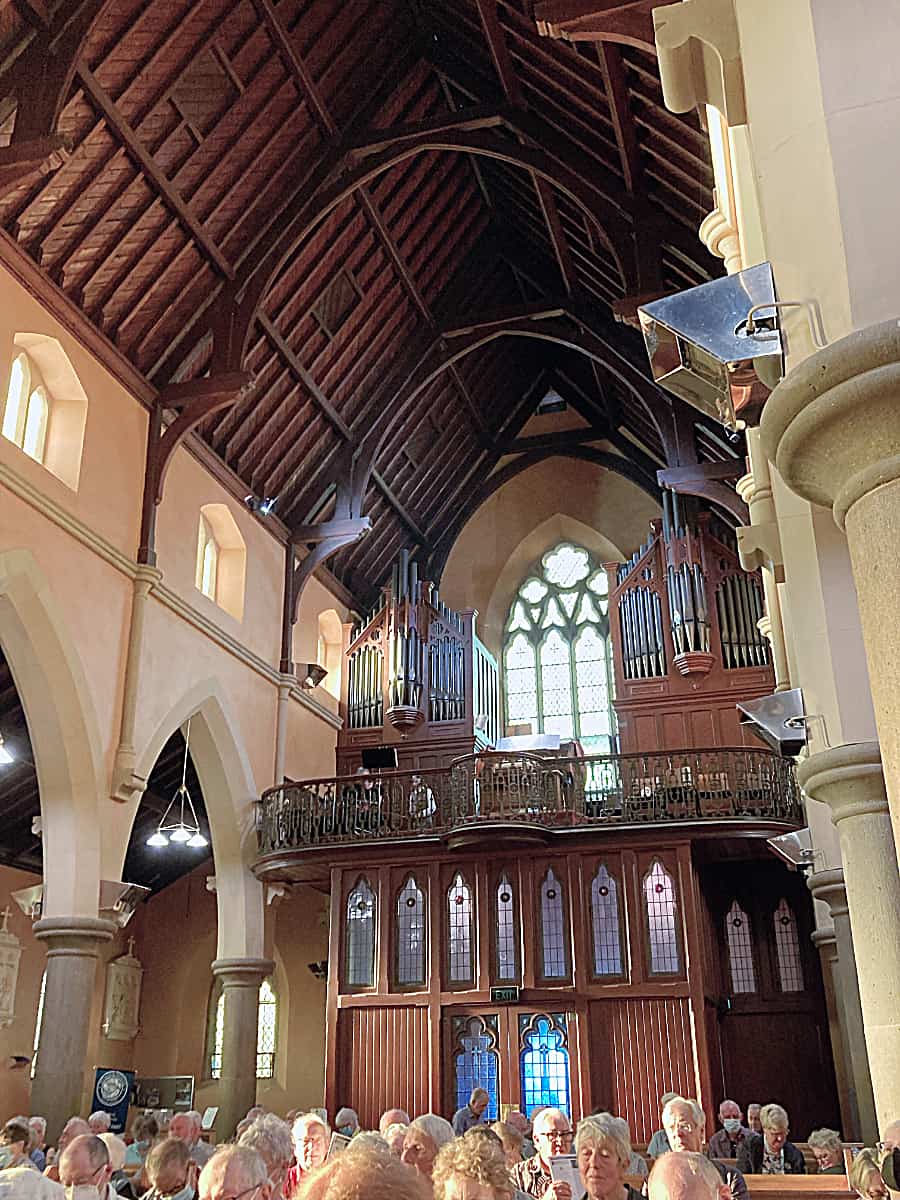
St Alipius’ Catholic Church, Ballarat – exterior
[photograph from Wikipedia Commons, accessed 23 January 2023]
Historical and Technical Documentation by John Maidment
© OHTA (last updated January 2023)
 St Alipius’ Catholic Church, Ballarat – exterior [photograph from Wikipedia Commons, accessed 23 January 2023] Historical and Technical Documentation by John Maidment © OHTA (last updated January 2023) |
The foundation stone of St Alipius’ Church, the oldest Catholic parish in Ballarat, was laid on 2 March 1873. The architect was Henry Richards Caselli (1816-1885) and Messrs Cocks, Brown & Co were the contractors. Five bays of the nave were built initially, with the completion of the building through the addition of an additional bay to the nave, chancel, side chapels and tower deferred.1 The first section of the building was opened in September 1874.2 On 3 January 1926, the completed building was blessed – the cost of the work exceeding 12,000 pounds.3 The building has recently been completely restored, with Mulholland Restoration and Decorating responsible for the internal paintwork.
 St Alipius’ Catholic Church, Ballarat – organ viewed from nave [photograph by Christopher Trikilis (January 2023)] |
The organ was built by Geo.Fincham & Son, of Richmond, and presented by Count T.J. O’Loughlin, at a cost of about 1,000 pounds. The instrument was designed according to specifications drawn up by Haydn West, Organist of St Patrick’s Cathedral, Ballarat. It was blessed on 15 September 1912.4 The organ was divided on either side of the large rear window, the two cases closely identical to those made by the Fincham firm for Mar Thoma Church (College Church), Parkville and St Andrew’s Presbyterian Church, Hamilton.
 St Alipius’ Catholic Church, Ballarat – organ cases [photograph by Jennifer Chou (January 2023)]  St Alipius’ Catholic Church, Ballarat – organ case detail [photograph by Jennifer Chou (January 2023)] |
The original specification was as follows:
| GREAT Open Diapason Stopt Diapason Wald Flute Dulciana Principal Flute Twelfth Fifteenth Clarinet Swell to Great Sub Swell to Great Swell to Great Super |
8 8 8 8 4 4 2-2/3 2 8 |
prepared-for |
|
| SWELL Bourdon Open Diapason Gedact Viol d’Orchestre Voix Celeste Gemshorn Flute Mixture Cornopean Oboe Tremulant |
16 8 8 8 8 4 4 3 rks 8 8 |
|
|
| PEDAL Open Diapason Bourdon Bass Flute Great to Pedal Swell to Pedal |
16 16 8 |
wood A A |
Compass: 61/30
Tubular-pneumatic action
4 thumb pistons to Great
4 thumb pistons to Swell
Reversible pistons for Swell to Great and Great to Pedal
Balanced swell pedal
Detached stopkey console5
 St Alipius’ Catholic Church, Ballarat – console [photograph by John Maidment (November 2006)] |
The organ was rebuilt in 1957 by Geo. Fincham & Sons Pty Ltd. A new stopkey console was supplied and the action was converted to electro-pneumatic. Minimal tonal changes were made to the original. The organ has since been cleaned and overhauled by Goldfields Pipe Organs.
| GREAT Open Diapason Stopped Diapason Wald Flute Dulciana Principal Clear Flute Fifteenth Clarinet Swell to Great Sub Swell to Great Swell to Great Super |
8 8 8 8 4 4 2 8 |
||
| SWELL Bourdon Open Diapason Gedact Viol d’Orchestre Voix Celeste Octave Piccolo Mixture Cornopean Oboe Tremulant Swell Sub Octave Swell Super Octave |
16 8 8 8 8 4 2 2 rks 8 8 |
TC |
|
| PEDAL Open Diapason Bourdon Principal Bass Flute Great to Pedal Swell to Pedal |
16 16 8 8 |
A wood B A B |
Compass: 61/30
Detached stopkey console
Electro-pneumatic action
Adjustable thumb pistons
Balanced swell pedal6
 St Alipius’ Catholic Church, Ballarat – console piston mechanism [photograph by Jennifer Chou (January 2023)]  St Alipius’ Catholic Church, Ballarat – interior looking towards high altar [photograph by John Maidment (November 2006)] |
1 Ballarat Star, 3 March 1873, p.2
2 Ibid., 18 September 1874, p.2
3 Advocate, 7 January 1926, p.14
4 Ibid., 21 September 1912, p.24; 31 August 1912, p.25
5 Specification supplied by John Cowan 1960s
6 Specification noted by John Maidment 1966